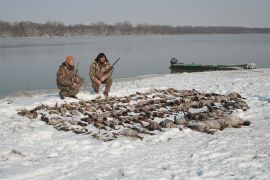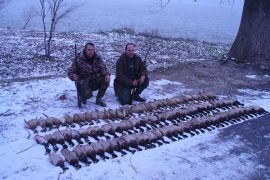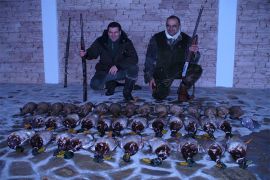Waterfowl hunting trips in Bulgaria - Hunting area кв Васил Левски Разград 7200
Goose hunting in Bulgaria - Hunting area кв Васил Левски Разград 7200
- Wildfowling - Goose hunting in Bulgaria
Wild duck hunting in Bulgaria - Hunting area кв Васил Левски Разград 7200
- Wildfowling - Wild duck hunting in Bulgaria
Find our discounted waterfowl hunting trips in Bulgaria
- Waterfowl hunting trips in Bulgaria directly from outfitters
» Bulgaria Hunting Trips » Waterfowl hunting in Bulgaria » Hunting area кв Васил Левски Разград 7200
- Hunting trips directly from outfitters:
Waterfowl hunting trips in Bulgaria
Hunting area кв Васил Левски Разград 7200
Book Your Waterfowl Hunts in Bulgaria
Waterfowl hunting trips in Bulgaria
Waterfowl hunting in Bulgaria
- ✓ Waterfowl hunting in Bulgaria
- кв Васил Левски Разград 7200
Waterfowl hunting in Bulgaria
Wild ducks hunting trips in Bulgaria
Wild duck hunting is one of the coldest and most exciting types of wing shooting in Bulgaria. There are three types of duck hunting. The first kind is at flight, early in the morning and at dusk. The second kind is with fake lures at the resting spots (reservoirs, dams, rivers and runoff water). The third kind is walked up hunting along river banks, canals and streams.
When hunting in the early hours of the morning, the hunters have to be at the hunting spots before dawn. The birds move from ther feeding spots towards the resting spots. Those are normally large dams and high-water rivers. Wearing warm clothes is recommended, but using camouflage coverings is a must, due to the fact that these birds have a sharp eyesight and a very acute sense of hearing. It is a good idea for hunters to use auditory decoys, so as to direct the birds towards themselves. You may use retriever dogs (Golden Retrievers, Labradors, Drahthaarts, Kurzhaarts and Setters). The dogs need to be very disciplined, compliant and to obey the command Stay in place!. Dogs with experience trace the shot birds by themselves and swiftly retrieve them for their guide.
During the hunts at dusk, it is advisable to lie in wait for the ducks at their feeding spots.
Those are: surface runoff areas (overland flow), harvested fields (rice fields), shallow streams, flooded corn fields (grooves filled with water). It is mandatory to use auditory decoys, so as to direct the birds towards the desired places. It is advisable to use retriever dogs, due to the fact that the hunt takes place in the darker hours of the day. For this kind of wing shooting in Bulgaria, using Drahthaars and Kurzhaars brings greater success. They are able to find the shot birds visually as well as by smell, while Labradors and Golden Retrievers tend to track the bird visually and are more suited for hunting at wide open water areas (reflective water surfaces).
Walked up hunting is the second method of hunting ducks. That is an emotion-filled outing involving long hikes, which is why the hunter must be in excellent health. This kind of hunt is most sucessful when the bigger dams in the area freeze over. Smaller canals and rivers do not allow the water to freeze even at temperatures below - 15 degrees. Birds are aware of that and they find favourable conditions to rest and eat. It is recommended to start this type of hunt at 6 am, and it can last until as late as 5 pm. It may then be combined with an evening hunt at dusk. Combined, the two types of hunt can bring wonderful results. During walked up hunts, it is good to use a guide who knows the places where the birds rest during the day. Once you near the resting spots, you need to move quietly and stay low. You need to use the surrounding vegetation as a cover while you approach the birds and use the element of surprise. It’s possible to lift between 20 and 50 birds into the air at one of these spots. When moving along a riverbank or canal, you need a disciplined dog that walks no more than 15 - 20 steps ahead of you. Once you near the resting spots, the dog must obey the command Heel! or Behind me! so as not to lift the resting game birds. In Bulgaria, the most widely established dog breeds are Drahthaar and Kurzhaar. Once the birds have been shot, the dogs must retrieve the birds from water as well as dry land under the command Retrieve!. The dog must be able to maneuvre through obstacles (water obstacles, fallen trees, ponds, etc.) - in other words, it needs to be hardy while retrieving.
The third kind of hunting is by lying in wait for the birds at their resting spots. Those are: large reservoirs (dams), surface runoffs. It is mandatory to use lures (decoys). It is advisable to put between 40 and 100 duck decoys into the water. It is good to have two or three pairs of spinning wing decoys (mojos). You may use mobile duck decoys with electric motors, so as to create the illusion that the birds are moving. The hunters need to have made a temporary hiding place at the river bank. It must blend in with the terrain so as not to arouse suspicion in the birds. A boat camouflaged with reed vegetation can be used for the same purpose. Hunting by boat allows the hunters to choose the hunting spots for themselves. When using decoys in such cases, they need to be mobile, with built-in chords and weights (so that they can be thrown directly from the boat).
Mallard Identification
Male has green head with olive green bill. Wings of both sexes have purplish / blue speculum and white underside. Concentrations of mallards are typically found near agricultural grain fields that are situated near wetlands or river courses. This species nest throughout country and especially in The Danube plain. Mallards typically return to feeding areas so scout your hunting area to locate where the birds are feeding. A mallard call can be quite successful in luring this bird to decoy spreads.
Geese hunting trips in Bulgaria
Goose hunting involves early mornings and very cold treks. This type of wing shooting in Bulgaria is effective while the birds are in flight in the morning and late afternoon.
In the morning the geese are stalked by the places they have rested at (big lakes and rivers). Places that offer a vantage point are chosen, allowing the hunters pick the birds off before they manage to climb beyond the hunters’ range. The best distance for shooting geese is about 30 to 40 m. This is a very resilient bird and that is why bigger pellets must be used (№ 1, № 0, № 2/0 and № 4/0).
In the late afternoon the geese can be stalked by the places they rest at overnight (big lakes and rivers), usually by the edge of the water. The use of goose calls is recommended in order to lure the birds in the desired direction. At dusk the shooting distance can range from 15 to 30 m.
The second way to hunt geese is at their feeding spots.These are fields with wheat crops still in the early stages of their growth, the main food source for the geese. After the field is chosen a hideout that blends in with its surroundings is constructed. The hideout can be set up some time before the hunt allowing the birds some time to get accustomed to its presence.
Decoys with and without spinning wings can be used as well as 3 artificial magpies and 50 to 100 static birds, mimicking a flock of feeding and resting geese. Other types of decoy birds can be used in order to create the illusion of a peaceful field. Shooting distance ranges between 15 to 30 m.
Hunters can use goose calls to direct the flocks to the desired spots and because the birds drop down from great heights the hunters must have patience and wait for them to come within range. Shooting is under the command of the guide (Now! etc.). These are powerful birds with good plumage. If shot at prematurely there is a chance to miss or wound the goose.
A retriever dog can be used. It must be well-disciplined and obey the command Stay! and must be kept inside the hideout. Geese hunts can last the entire day and the hunt itself is static and in cold weather.That is why heat insulating clothes, warm winter boots and neoprene socks are a must for this type of wing shooting in Bulgaria.
When to hunt Goose Geese?
Goose hunting season in the Bulgaria starts in Oktombre. It gains tempo when the geese begin their migration from Russia to warmer places.
- BOOK YOUR HUNT IN BULGARIA
Елен
1. Благороден елен
Едър дивеч
(Cervus elaphus)
Срокове на ловуване
Благороден елен:
- мъжки и приплоди - от 1 септември до 31 януари
- женски - от 1 октомври до 31 декември
Елен лопатар:
- мъжки и приплоди - от 1 септември до 31 януари
- женски - от 1 октомври до 31 декември
Разпространение на благородния елен
Благородният елен се среща в Средна и Западна Европа, европейската част на Русия, Средна Азия, Далечния Изток и в някои други райони. У нас е повсеместно разпространен в планинската и равнинна част на страната. Според ловната статистика числеността му възлиза на около 23 000 бр.
Общи сведения за благородния елен
Половият диморфизъм при благородният елен е силно изразен. По правило окраската на елена през лятото е червенокафява, а през зимата сиво кафява. Коремът, вътрешната страна на краката и около опашката са кално мръсно бели. Дължина на тялото -165-250 сm. Височина при холката -100-150 сm. Дължина на опашката - 12-14 сm. Тегло - 100-450 kg. Женските са с от една четвърт, до една трета по-леки и нямат рога по време на размножителния период. Мъжкият сменя рогата си всяка година, от март до края на април. При силните рогачи рогата опадват през февруари - март, а по-малките и по-слабите - през април - май. Новите рога израстват за около 4 месеца. При растежа те са покрити с добре кръвоносноснабдена кожица, която след израстването на рогата изсъхва. През юли август рогачите търкат рогата си по дърветата и обелват сухата кожа (ликото). Падането на рогата се предизвиква от рязка промяна в нивата на различните хормони в кръвта. То е съпроводено с леко кървене и отваряне на рана, която зараства много бързо. На едногодишните екземпляри рогата са много малки и недоразвити, имат едно, максимум две разклонения, на втората година могат да бъдат вече шест. С възрастта рогата стават все по-големи, мощни и разклонени. Максимум се достига около десетата година, когато разклоненията им могат да достигнат 24 или повече на брой, тогава е оптималната възраст за отстрелване на капитални трофеи. Когато животното започне да остарява, рогата започват да намаляват размера си. Женските (кошутите) са без рога.
Начин на живот и хранене на благородния елен
Елените се хранят привечер, през нощта и рано сутрин. В тихите и спокойни места за кратко време пасат и през деня, а през останалото време почиват и преживят. Те използват растителна храна - трева, листа и клонки от дървесни и храстови видове, културни растения, жълъди, горски семена и плодове. През зимата с охота се хранят с къпини, малини, зеленика, трепетлика, ива и др. Някои елени се пристрастяват и белят кора от младите дръвчета. Обикновено елените живеят на малки стада, съставени само от мъжки или женски индивиди, които се смесват само в размножителния период. Те са слабо привързани към определена територия и често странстват на големи разстояния. Въпреки големите си, със заострени шипове и крайно опасни рога, когато са заплашени и мъжките и женските се защитават удряйки силно с предните си копита и не са редки случаите на тежко пострадал хищник след опит за нападение над кошута с малко. Благородният елен, понякога обича да се валя в кал, което не е характерно за другите видове от семейство Плътнороги. Кошутите, теленцата и част от младите рогачи прекарват зимата на стада, които се разпадат през пролетта, преди раждането на малките. Останалите мъжкари прекарват зимата и лятото сами или на групи.
Размножаване на благородния елен
Кошутите са полово зрели на 2 години, а мъжките са полово зрели и годни да оплождат след 3-та година, но участват реално в размножаването след като навършат 5-6 години, когато са в състояние да се преборят за женската. Брачният период на елена започва към 20-25 август в по-южните и по-топли райони, а в планинските места - през първата половина на септември и продължава около един месец. Силните рогачи събират около себе си 4-5, а понякога и повече кошути, които ревниво пазят, докато ги оплодят. По време на сватбуването мъжките реват, като особено активен е ревът им сутрин и привечер. През брачния период рогачите почти не се хранят, а само пият вода и се калят, поради което отслабват много. След сватбуването мъжкарите се оттеглят в глухи места, започват да се хранят интензивно и бързо се подготвят за зимата. Женските, когато раждат се отделят за известно време от стадото и след това отново се присъединяват. Бременността на кошутите продължава около 8 месеца (240-250 дни) и в края на май и началото на юни те раждат по 1, рядко по 2 теленца, които бързо укрепват и след няколко дни вече могат да следват майка си. Неприятели на елените са вълците, чакалите, лисиците и рядко мечките и подивели кучета. Теленцата могат да станат жертва и на някои от едрите грабливи птици.
Стопанско значение на благородния елен
Благородният елен е ценен ловен обект, за който се полагат грижи и се поддържа популацията му. Обикновено са разрешени за лов единствено мъжкарите и то само за кратък определен период. Изключение прави подборния лов, който цели да поддържа доброто състояние на популацията и качеството на наследствения материал. Ловният трофей са рогата му. В България е отстрелян световният рекорд на трофей от благороден елен, с оценка 273,6 точки по CIC. Страната притежава 15 трофеи с оценка над 250 т. по CIC. Десет от първите 20 трофеи в света са български. Предлагат се трофейни екземпляри с тегло на рогата от 7 до 14 kg.
- BOOK YOUR HUNT IN BULGARIA
2. Елен-лопатар
Едър дивеч
(Dama dama)
Разпространение на елена лопатар
Еленът-лопатар произхожда от средиземноморските острови, откъдето е бил разселен по изкуствен начин в много европейски страни. У нас е аклиматизиран преди около 70 години, но на свобода се развъжда през последните 25-30 години. Понастоящем се среща почти повсеместно. Числеността му у нас е около 50 000 бр.
Общи сведения за елена лопатар
Еленът-лопатар е получил името си от лопатовидната форма на рогата си. Значително по-дребен е от благородния елен. Тялото му е набито и дебело, а краката са относително къси. Рогачът достига на дължина 130-140 сm и височина - 85-90 сm, тежи около 80-90 kg. Женската е по-малка и достига на тегло 35-50 kg. Козината му през лятото е ръждивочервена, изпъстрена с кръгли бели петна от двете страни, главата отгоре и страните са кафеникави, а коремът и вътрешната страна на краката бели. Огледалото е също така бяло и е оградено с черна ивица. През зимата козината е еднообразно сиво-кафява. Често се срещат изцяло бели и черни екземпляри. Линее през април и октомври. Първите рога на елена-лопатар, които израстват през втората година, са шиловидни без розетка, а вторите рога, които израстват, след като е навършил три години, имат лопатовидно разширение към върха. През следващите години лопатата расте на дължина, след което се увеличават ширината и масата на рогата. Нормално израсналият лопатар има добре развити очни и средни шипове. Рогата достигат максималните си размери към 10-12-годишна възраст. Еленът-лопатар ги сменя всяка година през април-май. Новите рога израстват бързо и към края на август или началото на септември са с нормална големина и напълно оформени. На тежина достигат 3-4 kg.
Начин на живот и хранене на елена лопатар
Еленът-лопатар обитава равнинните широколистни и смесени гори. Оптимални условия за неговото развитие са крайбрежията с по-топъл и влажен климат. В такива места той развива едро тяло и мощни рога. Подходящ е за развъждане в паркове. Изкачва се и в планините, където има изобилие на поляни и разнообразна тревна, храстова и дървесна растителност. Избягва северните изложения, сенчестите места и районите с дебела снежна покривка Силно е привързан към местообитанията си, но при липса на храна и вода, както и през сватбения период предприема странствания. Силните мъжки екземпляри се движат най-често сами. Еленът-лопатар не се каля. На паша излиза както през деня, така и през нощта. Към храната си е невзискателен, храни се с трева, листа на дървета и храсти, различни гъби и горски плодове. По-доверчив е от благородния елен. Има силно обоняние и зрение. Бяга по-бавно, поради което трудно се спасява от неприятели. Най-големият неприятел на елена-лопатар е вълкът, а на места овчарските и скитащите кучета. Лисицата и чакалът нападат теленцата.
Размножаване при елена лопатар
Сватбеният период започва от средата на октомври и продължава до края на ноември. Бременността трае около 240-250 дни. През юни женската ражда 1-2 малки, които през първите няколко дни са безпомощни.
Стопанско значение на елена лопатар
Еленът-лопатар у нас се е развъждал в парковете като декоративен вид, но през последните двадесет години се разселва масово и като обект на лов. Причинява щети на горското и селското стопанство. Особено вреди на декоративната растителност в парковете. Месото му е вкусно, а рогата са ценен трофей. Национален рекорд за страната е 208,59 т. по СIС. Предлагат се трофейни екземпляри с тегло на рогата от 3 до 5 kg.



